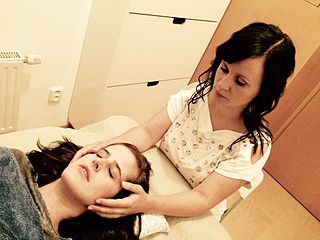
Osteopathy is a type of alternative medicine that emphasizes physical manipulation of the body's muscle tissue and bones. Practitioners of osteopathy are referred to as osteopaths. Its name derives from Ancient Greek "bone" (ὀστέον) and "sensitive to" or "responding to" (-πάθεια).

The autonomic nervous system (ANS), formerly the vegetative nervous system, is a division of the peripheral nervous system that supplies smooth muscle and glands, and thus influences the function of internal organs. The autonomic nervous system is a control system that acts largely unconsciously and regulates bodily functions, such as the heart rate, digestion, respiratory rate, pupillary response, urination, and sexual arousal. This system is the primary mechanism in control of the fight-or-flight response.
Osteopathic medicine is a branch of the medical profession in the United States. Osteopathic physicians (DOs) are licensed to practice medicine and surgery in all 50 states and are recognized to varying degrees in 85 other countries. The field is distinct from osteopathic practices offered in nations outside of the U.S., whose graduates and practitioners are generally not considered part of core medical staff nor of medicine itself. Only graduates of American osteopathic medical colleges may practice the full scope of medicine and surgery generally considered to be medicine by the general public.

The fight-or-flight response is a physiological reaction that occurs in response to a perceived harmful event, attack, or threat to survival. It was first described by Walter Bradford Cannon. His theory states that animals react to threats with a general discharge of the sympathetic nervous system, preparing the animal for fighting or fleeing. More specifically, the adrenal medulla produces a hormonal cascade that results in the secretion of catecholamines, especially norepinephrine and epinephrine. The hormones estrogen, testosterone, and cortisol, as well as the neurotransmitters dopamine and serotonin, also affect how organisms react to stress. The hormone osteocalcin might also play a part.

Craniosacral therapy (CST) is a form of bodywork or alternative therapy that uses gentle touch to palpate the synarthrodial joints of the cranium. It is based on fundamental misconceptions about the physiology of the human skull and is promoted as a cure-all for a variety of health conditions.
The baroreflex or baroreceptor reflex is one of the body's homeostatic mechanisms that helps to maintain blood pressure at nearly constant levels. The baroreflex provides a rapid negative feedback loop in which an elevated blood pressure reflexively causes the heart rate to decrease and also causes blood pressure to decrease. Decreased blood pressure decreases baroreflex activation and causes heart rate to increase and to restore blood pressure levels. The baroreflex can begin to act in less than the duration of a cardiac cycle and thus baroreflex adjustments are key factors in dealing with postural hypotension, the tendency for blood pressure to decrease on standing due to gravity.
Reciprocal inhibition describes the relaxation of muscles on one side of a joint to accommodate contraction on the other side. In some allied health disciplines, this is known as reflexive antagonism. The central nervous system sends a message to the agonist muscle to contract. The tension in the antagonist muscle is activated by impulses from motor neurons, causing it to relax.
Vasomotor refers to actions upon a blood vessel which alter its diameter. More specifically, it can refer to vasodilator action and vasoconstrictor action.

Ganglioneuroma is a rare and benign tumor of the autonomic nerve fibers arising from neural crest sympathogonia, which are completely undifferentiated cells of the sympathetic nervous system. However, ganglioneuromas themselves are fully differentiated neuronal tumors that do not contain immature elements.

Bretylium (also bretylium tosylate) is an antiarrhythmic agent. It blocks the release of noradrenaline from nerve terminals. In effect, it decreases output from the peripheral sympathetic nervous system. It also acts by blocking K+ channels and is considered a class III antiarrhythmic. The dose is 5–10 mg/kg and side effects are high blood pressure followed by low blood pressure and ventricular ectopy.
Muscle Energy Techniques (METs) describes a broad class of manual therapy techniques directed at improving musculoskeletal function or joint function, and improving pain. METs are commonly used by manual therapists, physical therapists, chiropractors, athletic trainers, osteopathic physicians, and massage therapists. Muscle energy requires the patient to actively use his or her muscles on request to aid in treatment. Muscle energy techniques are used to treat somatic dysfunction, especially decreased range of motion, muscular hypertonicity, and pain.

Phosmet is a phthalimide-derived, non-systemic, organophosphate insecticide used on plants and animals. It is mainly used on apple trees for control of codling moth, though it is also used on a wide range of fruit crops, ornamentals, and vines for the control of aphids, suckers, mites, and fruit flies.

Norepinephrine (NE), also called noradrenaline (NA) or noradrenalin, is an organic chemical in the catecholamine family that functions in the brain and body as a hormone and neurotransmitter. The name "noradrenaline", derived from Latin roots meaning "at/alongside the kidneys", is more commonly used in the United Kingdom; in the United States, "norepinephrine", derived from Greek roots having that same meaning, is usually preferred. "Norepinephrine" is also the international nonproprietary name given to the drug. Regardless of which name is used for the substance itself, parts of the body that produce or are affected by it are referred to as noradrenergic.

Kansas City University (KCU) is a private medical school with its main campus in Kansas City, Missouri and an additional campus in Joplin, Missouri. Founded in 1916, KCU is one of the original osteopathic medical schools in the United States. It consists of both a College of Osteopathic Medicine and a College of Biosciences. KCU is one of the largest medical schools in the nation by enrollment.

A.T. Still University (ATSU) is a private medical school based in Kirksville, Missouri, with a second campus in Arizona. It is accredited by the Higher Learning Commission. ATSU includes two campuses on 200 acres with six schools and colleges. ATSU offers degrees in athletic training, audiology, dentistry, occupational therapy, physical therapy, and osteopathic medicine. Founded in 1892 by Dr. Andrew Taylor Still, it was the world's first osteopathic medical school. In 1995, a new campus opened in Arizona.
Doctor of Osteopathic Medicine is a professional doctoral degree of osteopathic medicine offered by medical schools in the United States. A DO graduate may become licensed as an osteopathic physician, similar to a physician who has earned the Doctor of Medicine (MD) degree. There is a distinction between osteopathic physicians trained within the United States and those trained outside of the United States. Osteopathic physicians, or DOs, currently have unlimited practice rights in roughly 74 countries, with partial practice rights in many more; DOs have full practice rights in all 50 US states. As of 2018, there were more than 145,000 osteopathic physicians and osteopathic medical students in the United States.
Osteomyology is a form of alternative medicine found almost exclusively in the United Kingdom and is loosely based on aggregated ideas from other manipulation therapies, principally chiropractic and osteopathy. Osteomyologists are often therapists who have usually been trained in osteopathy or chiropractic but take on the title osteomyologist after they have refused to be regulated by the General Osteopathic Council (GOsC) or the General Chiropractic Council (GCC) for political or philosophical reasons, or cannot join as they have not submitted the required papers to the governing bodies or achieved training standards necessary to satisfy the terms of the acts of parliament.
The American Osteopathic Board of Neurology and Psychiatry (AOBNP) is an organization that provides board certification to qualified Doctors of Osteopathic Medicine (D.O.) who specialize in disorders of the nervous system (neurologists) and to qualified Doctors of Osteopathic Medicine who specialize in the diagnosis and treatment of mental disorders (psychiatrists).
Paroxysmal sympathetic hyperactivity (PSH) is a syndrome that causes episodes of increased activity of the sympathetic nervous system. Hyperactivity of the sympathetic nervous system can manifest as increased heart rate, increased respiration, increased blood pressure, diaphoresis, and hyperthermia. Previously, this syndrome has been identified as general dysautonomia but now is considered a specific form of it. It has also been referred to as paroxysmal sympathetic instability with dystonia, or PAID, and sympathetic storm. Recently, however, studies have adopted the name paroxysmal sympathetic hyperactivity to ensure specificity. PSH is observed more in younger patients than older ones. It is also seen more commonly in men than women. There is no known reason why this is the case, although it is suspected pathophysiological links may exist. In patients surviving traumatic brain injury, the occurrence of these episodes is one in every three. PSH can also be associated with severe anoxia, subarachnoid and intracerebral hemorrhage, and hydrocephalus.
California Health Sciences University (CHSU) is a private, for-profit university located in Clovis, in the U.S. state of California. Founded in 2012, the school operates two academic programs, which offer doctoral degrees in pharmacy and osteopathic medicine. Graduates of the College of Osteopathic Medicine will receive the Doctor of Osteopathic Medicine degree. The College of Osteopathic Medicine holds candidate status by the American Osteopathic Association's (AOA) Commission on Osteopathic College Accreditation (COCA).










